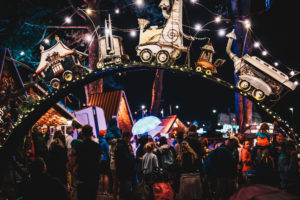Spring is here and the festival season is now starting. There are now hundreds of events across the UK showcasing art, theatre and music. This year, the New Note Orchestra will be part of the Brighton Fringe, playing at Caravansarai, a new pop-up site, on the 9th May with the Hullabaloo Community Quire.
The UK has a rich history of arts festivals, presenting the best of the country’s high-brow cultural output with events like the Proms and the numerous theatre festivals that take place in London and other cities. At the same time, fringe festivals are often seen as a haven for artists looking to take risks and experiment with their craft, free from the pressures and constraints of more mainstream platforms. It is this freedom that has made fringe festivals an important part of the UK’s cultural landscape, providing a platform for artists of all kinds to showcase their work, regardless of genre or commercial viability.
Capital of Culture
 One of the most popular fringe festivals in the UK is the Edinburgh Fringe, which has been running since 1947. The festival was born out of a desire to provide an alternative to the Edinburgh International Festival, which was perceived as elitist and inaccessible. The first year of the Edinburgh Fringe saw eight theatre companies perform in venues across the city, but since then it has grown to become the largest arts festival in the world, with thousands of artists and performers taking part every year.
One of the most popular fringe festivals in the UK is the Edinburgh Fringe, which has been running since 1947. The festival was born out of a desire to provide an alternative to the Edinburgh International Festival, which was perceived as elitist and inaccessible. The first year of the Edinburgh Fringe saw eight theatre companies perform in venues across the city, but since then it has grown to become the largest arts festival in the world, with thousands of artists and performers taking part every year.
The Edinburgh fringe festival is now one of the most famous festivals in the world, and draws acts both large and small. Stephen Fry is one of the most famous performers to have started out at the Edinburgh Festival. He first performed at the festival in 1981 with the Cambridge Footlights. This performance launched his career and led to him being cast in the BBC comedy Blackadder and since then, Fry has become a household name, appearing in numerous films, TV shows, and stage productions.
Miranda Hart is another performer who got her start at the Edinburgh Festival. She first performed at the festival in 2001 with her one-woman show, Miranda Hart – Throbs, Bags and Joy. This performance led to her BBC sitcom Miranda.
John Cleese first performed at the festival in 1963 with the Cambridge Footlights, a grouop that had launched a number of other big names. He then went on to work on the BBC and found the seminal comedy act Monty Python’s Flying Circus. Since then, Cleese has become a successful actor, writer, and producer, appearing in numerous TV shows, films, and stage productions.
Jemaine Clement and Bret McKenzie. They first performed at the Edinburgh Festival in 2002 with their show, Flight of the Conchords. The New Zealand-based comedy musicians then went on to make their own Radio Show and acclaimed TV series.
Success in the South
The success of the Edinburgh Fringe has led to the establishment of fringe festivals in other cities across the UK, each with their own unique character and flavour. The Brighton Fringe has been running since 1968 and has always been known for its eclectic mix of performances, with everything from theatre and dance to cabaret and comedy on offer. The festival has played host to a number of unusual and offbeat acts over the years, including a naked acrobat, a one-man band, and a show about the mating habits of insects.
own unique character and flavour. The Brighton Fringe has been running since 1968 and has always been known for its eclectic mix of performances, with everything from theatre and dance to cabaret and comedy on offer. The festival has played host to a number of unusual and offbeat acts over the years, including a naked acrobat, a one-man band, and a show about the mating habits of insects.
Another festival that has gained a reputation for showcasing the unusual and the avant-garde is the Buxton Fringe, which has been running since 1980. The festival takes place in the picturesque spa town of Buxton, in the heart of the Peak District, and is known for its quirky and idiosyncratic performances. In recent years, the festival has played host to a range of experimental and boundary-pushing shows, including a one-man show about the life of a bumblebee, and a performance art piece that involved a man sitting in a bathtub full of custard for two hours.
The Buxton Fringe has also been a platform for emerging talent, providing a space for young artists and performers to showcase their work and build their audiences. The festival runs a number of initiatives aimed at supporting up-and-coming artists, including a programme of workshops and mentoring sessions.
The Camden Fringe, which has been running since 2006, is another festival that has gained a reputation for showcasing the unusual and the unconventional. The festival takes place in venues across the London borough of Camden, and features everything from theatre and comedy to music and cabaret. In recent years, the festival has played host to a number of shows that have pushed the boundaries of convention, including a play about the life of a penguin, and a performance art piece that involved a woman sitting in a bath of baked beans.
One of the things that sets fringe festivals apart from more traditional arts festivals is their willingness to take risks and push boundaries. For many artists, fringe festivals provide a space in which to experiment and try out new ideas, without the pressures of commercial success or critical acclaim. This willingness to take risks has led to some of the most exciting and innovative work in contemporary theatre, dance, and performance.
Caravan of Love
In recent years, Brighton Fringe has continued to push the boundaries of what’s possible, with new venues and innovative programming. One of the most exciting developments is the introduction of Caravanserai, a pop-up outdoor festival site created by artist Pete Bateman. Located north of St Peter’s Church, Caravanserai will feature repurposed caravans and vintage fairground waltzers, creating an immersive experience for visitors. The site will be free-to-enter, and will include street food stalls, a family area, and a box office.
 Caravanserai will host two theatre venues, including a 220-seater big top, Luna Parc, showcasing theatre, circus, and cabaret. The smaller of the two venues, Junk Poet’s, is a bespoke 50-seater bandstand venue featuring intimate comedy, spoken word, and theatre events. Brighton Fringe CEO Julian Caddy is excited about the new venue, stating that it will be “a collaborative space where all venues and participants can come together, community groups and charities can benefit from the Brighton Fringe platform, and our audience can discover some of the best live performances from across the world.” The site will also play host to a community programme of workshops and talks in collaboration with Brighton Fringe’s charity partners.
Caravanserai will host two theatre venues, including a 220-seater big top, Luna Parc, showcasing theatre, circus, and cabaret. The smaller of the two venues, Junk Poet’s, is a bespoke 50-seater bandstand venue featuring intimate comedy, spoken word, and theatre events. Brighton Fringe CEO Julian Caddy is excited about the new venue, stating that it will be “a collaborative space where all venues and participants can come together, community groups and charities can benefit from the Brighton Fringe platform, and our audience can discover some of the best live performances from across the world.” The site will also play host to a community programme of workshops and talks in collaboration with Brighton Fringe’s charity partners.
Caravanserai was established at Camp Bestival in 2013, and has since become one of the most popular and innovative festival sites in the UK.
The New Note Orchestra will be playing at Caravanserai on Tuesday, 9th May at 7.15 along with the Hullaballoo Community Quire.
Tickets are £7 with £3.50 concessions and are available at the link below
https://www.brightonfringe.org/events/new-note-orchestra-and-hullabaloo-community-quire/

